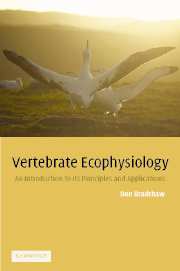Book contents
- Frontmatter
- Contents
- Introduction
- 1 Homeostasis: a fundamental organising paradigm in ecophysiology
- 2 Stress: the concept and the reality
- 3 Basic methods used in ecophysiological studies
- 4 Turnover methodology: theory and practice
- 5 Case studies of stress: incidence and intensity
- 6 Survival in deserts
- 7 Torpor and hibernation in cold climates
- 8 Marine birds and mammals
- 9 Conclusion
- Appendix 1 Population estimation methods
- Appendix 2 Estimation of food intake in Tiliqua rugosa
- Appendix 3 Simultaneous measurement of sodium and potassium concentration in plasma or urine using the IL 143 digital flame photometer
- Appendix 4 Determination of plasma urea nitrogen
- Appendix 5 Radioimmunoassay of testosterone in plasma
- Appendix 6 Preparation of ‘stripped plasma’
- Appendix 7 Radioimmunoassay of testosterone in faeces
- Appendix 8 The comparative method
- Appendix 9 Basic turnover equations
- References
- Index
4 - Turnover methodology: theory and practice
Published online by Cambridge University Press: 05 June 2012
- Frontmatter
- Contents
- Introduction
- 1 Homeostasis: a fundamental organising paradigm in ecophysiology
- 2 Stress: the concept and the reality
- 3 Basic methods used in ecophysiological studies
- 4 Turnover methodology: theory and practice
- 5 Case studies of stress: incidence and intensity
- 6 Survival in deserts
- 7 Torpor and hibernation in cold climates
- 8 Marine birds and mammals
- 9 Conclusion
- Appendix 1 Population estimation methods
- Appendix 2 Estimation of food intake in Tiliqua rugosa
- Appendix 3 Simultaneous measurement of sodium and potassium concentration in plasma or urine using the IL 143 digital flame photometer
- Appendix 4 Determination of plasma urea nitrogen
- Appendix 5 Radioimmunoassay of testosterone in plasma
- Appendix 6 Preparation of ‘stripped plasma’
- Appendix 7 Radioimmunoassay of testosterone in faeces
- Appendix 8 The comparative method
- Appendix 9 Basic turnover equations
- References
- Index
Summary
Basic assumptions
Many of the insights into the lives of animals that have been gained through the application of the ecophysiological approach come from turnover studies, using stable and radioactive isotopes. It is thus important not only to be able to implement such studies, but also to understand the strengths and limitations of the technology. Details of the basic turnover equation are given in Chapter 3 and Appendix 9, and the following outlines the various assumptions on which the method is based, along with mathematical procedures that have been introduced by various authors to cope with situational realities. There are six basic assumptions, most of which are violated to some extent in practice. These are discussed in great depth by Speakman (1997) and by Nagy (1980, 1983), to which reference should be made for specific details.
Rates of CO2 production and water loss are constant
Clearly, this is never the case in reality, as animals feed and consume water over short periods of time, and changes in rates of activity will affect rates of gas exchange. Attempts to track varying rates of CO2 production, by multiple sampling, are usually self-defeating as they involve capturing and bleeding the animal a number of times and the time interval is often too short to allow discrimination of slowly changing isotope levels. Rates of CO2 production measured by the doubly labelled water (DLW) method are always averages over a given time span and are thus difficult to correlate with specific behaviours, or levels of activity.
- Type
- Chapter
- Information
- Vertebrate EcophysiologyAn Introduction to its Principles and Applications, pp. 58 - 77Publisher: Cambridge University PressPrint publication year: 2003



